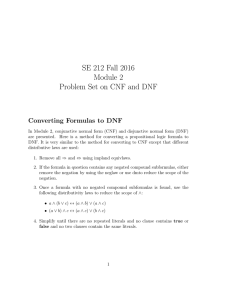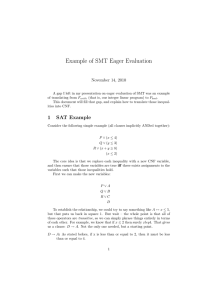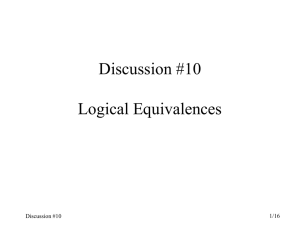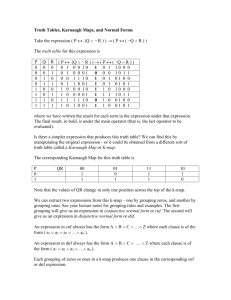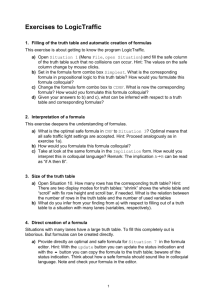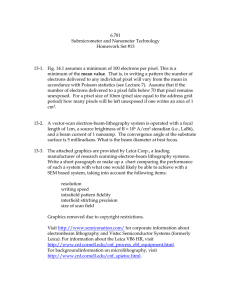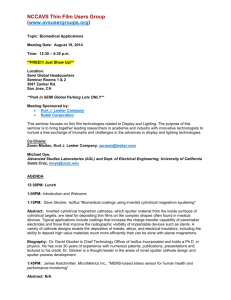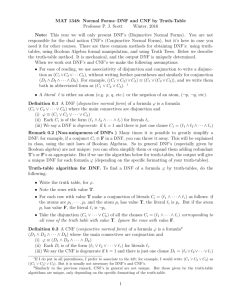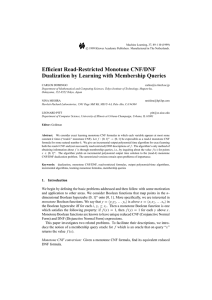Substitution Theorem
advertisement
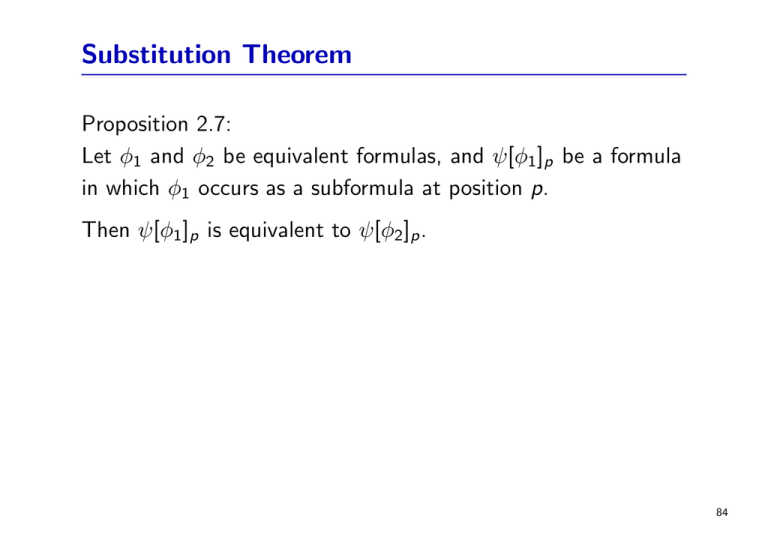
Substitution Theorem Proposition 2.7: Let φ1 and φ2 be equivalent formulas, and ψ[φ1 ]p be a formula in which φ1 occurs as a subformula at position p. Then ψ[φ1 ]p is equivalent to ψ[φ2 ]p . 84 Equivalences Proposition 2.8: The following equivalences are valid for all formulas φ, ψ, χ: (φ ∧ φ) ↔ φ Idempotency ∧ (φ ∨ φ) ↔ φ Idempotency ∨ (φ ∧ ψ) ↔ (ψ ∧ φ) Commutativity ∧ (φ ∨ ψ) ↔ (ψ ∨ φ) Commutativity ∨ (φ ∧ (ψ ∧ χ)) ↔ ((φ ∧ ψ) ∧ χ) Associativity ∧ (φ ∨ (ψ ∨ χ)) ↔ ((φ ∨ ψ) ∨ χ) Associativity ∨ (φ ∧ (ψ ∨ χ)) ↔ (φ ∧ ψ) ∨ (φ ∧ χ) Distributivity ∧∨ (φ ∨ (ψ ∧ χ)) ↔ (φ ∨ ψ) ∧ (φ ∨ χ) Distributivity ∨∧ 85 Equivalences (φ ∧ φ) ↔ φ Absorption ∧ (φ ∨ φ) ↔ φ Absorption ∨ (φ ∧ (φ ∨ ψ)) ↔ φ Absorption ∧∨ (φ ∨ (φ ∧ ψ)) ↔ φ Absorption ∨∧ (φ ∧ ¬φ) ↔ ⊥ Introduction ⊥ (φ ∨ ¬φ) ↔ ⊤ Introduction ⊤ 86 Equivalences ¬(φ ∨ ψ) ↔ (¬φ ∧ ¬ψ) De Morgan ¬∨ ¬(φ ∧ ψ) ↔ (¬φ ∨ ¬ψ) De Morgan ¬∧ ¬⊤ ↔ ⊥ Propagate ¬⊤ ¬⊥ ↔ ⊤ Propagate ¬⊥ 87 Equivalences (φ ∧ ⊤) ↔ φ Absorption ⊤∧ (φ ∨ ⊥) ↔ φ Absorption ⊥∨ (φ → ⊥) ↔ ¬φ Eliminate ⊥ → (φ ↔ ⊥) ↔ ¬φ Eliminate ⊥ ↔ (φ ↔ ⊤) ↔ φ Eliminate ⊤ ↔ (φ ∨ ⊤) ↔ ⊤ Propagate ⊤ (φ ∧ ⊥) ↔ ⊥ Propagate ⊥ 88 Equivalences (φ → ψ) ↔ (¬φ ∨ ψ) Eliminate → (φ ↔ ψ) ↔ (φ → ψ) ∧ (ψ → φ) Eliminate1 ↔ (φ ↔ ψ) ↔ (φ ∧ ψ) ∨ (¬φ ∧ ¬ψ) Eliminate2 ↔ For simplification purposes the equivalences are typically applied as left to right rules. 89 2.4 Normal Forms We define conjunctions of formulas as follows: V0 i=1 φi = ⊤. V1 i=1 φi = φ1 . Vn Vn+1 i=1 φi ∧ φn+1 . i=1 φi = and analogously disjunctions: W0 i=1 φi = ⊥. W1 i=1 φi = φ1 . Wn Wn+1 i=1 φi ∨ φn+1 . i=1 φi = 90 Literals and Clauses A literal is either a propositional variable P or a negated propositional variable ¬P. A clause is a (possibly empty) disjunction of literals. 91 CNF and DNF A formula is in conjunctive normal form (CNF, clause normal form), if it is a conjunction of disjunctions of literals (or in other words, a conjunction of clauses). A formula is in disjunctive normal form (DNF), if it is a disjunction of conjunctions of literals. Warning: definitions in the literature differ: are complementary literals permitted? are duplicated literals permitted? are empty disjunctions/conjunctions permitted? 92 CNF and DNF Checking the validity of CNF formulas or the unsatisfiability of DNF formulas is easy: A formula in CNF is valid, if and only if each of its disjunctions contains a pair of complementary literals P and ¬P. Conversely, a formula in DNF is unsatisfiable, if and only if each of its conjunctions contains a pair of complementary literals P and ¬P. On the other hand, checking the unsatisfiability of CNF formulas or the validity of DNF formulas is known to be coNP-complete. 93 Conversion to CNF/DNF Proposition 2.9: For every formula there is an equivalent formula in CNF (and also an equivalent formula in DNF). Proof: We consider the case of CNF and propose a naive algorithm. Apply the following rules as long as possible (modulo associativity and commutativity of ∧ and ∨): Step 1: Eliminate equivalences: (φ ↔ ψ) ⇒ECNF (φ → ψ) ∧ (ψ → φ) 94 Conversion to CNF/DNF Step 2: Eliminate implications: (φ → ψ) ⇒ECNF (¬φ ∨ ψ) Step 3: Push negations downward: ¬(φ ∨ ψ) ⇒ECNF (¬φ ∧ ¬ψ) ¬(φ ∧ ψ) ⇒ECNF (¬φ ∨ ¬ψ) Step 4: Eliminate multiple negations: ¬¬φ ⇒ECNF φ 95 Conversion to CNF/DNF Step 5: Push disjunctions downward: (φ ∧ ψ) ∨ χ ⇒ECNF (φ ∨ χ) ∧ (ψ ∨ χ) Step 6: Eliminate ⊤ and ⊥: (φ ∧ ⊤) ⇒ECNF φ (φ ∧ ⊥) ⇒ECNF ⊥ (φ ∨ ⊤) ⇒ECNF ⊤ (φ ∨ ⊥) ⇒ECNF φ ¬⊥ ⇒ECNF ⊤ ¬⊤ ⇒ECNF ⊥ 96 Conversion to CNF/DNF Proving termination is easy for steps 2, 4, and 6; steps 1, 3, and 5 are a bit more complicated. The resulting formula is equivalent to the original one and in CNF. The conversion of a formula to DNF works in the same way, except that conjunctions have to be pushed downward in step 5. 2 97 Complexity Conversion to CNF (or DNF) may produce a formula whose size is exponential in the size of the original one. 98 Satisfiability-preserving Transformations The goal “find a formula ψ in CNF such that φ |=| ψ” is unpractical. But if we relax the requirement to “find a formula ψ in CNF such that φ |= ⊥ ⇔ ψ |= ⊥” we can get an efficient transformation. 99 Satisfiability-preserving Transformations Idea: A formula ψ[φ]p is satisfiable if and only if ψ[P]p ∧ (P ↔ φ) is satisfiable where P is a new propositional variable that does not occur in ψ and works as an abbreviation for φ. We can use this rule recursively for all subformulas in the original formula (this introduces a linear number of new propositional variables). Conversion of the resulting formula to CNF increases the size only by an additional factor (each formula P ↔ φ gives rise to at most one application of the distributivity law). 100 Optimized Transformations A further improvement is possible by taking the polarity of the subformula into account. For example if ψ[φ1 ↔ φ2 ]p and pol(ψ, p) = −1 then for CNF transformation do ψ[(φ1 ∧ φ2 ) ∨ (¬φ1 ∧ ¬φ2 )]p . 101 Optimized Transformations Proposition 2.10: Let P be a propositional variable not occurring in ψ[φ]p . If pol(ψ, p) = 1, then ψ[φ]p is satisfiable if and only if ψ[P]p ∧ (P → φ) is satisfiable. If pol(ψ, p) = −1, then ψ[φ]p is satisfiable if and only if ψ[P]p ∧ (φ → P) is satisfiable. If pol(ψ, p) = 0, then ψ[φ]p is satisfiable if and only if ψ[P]p ∧ (P ↔ φ) is satisfiable. Proof: Exercise. 2 102 Optimized Transformations The number of eventually generated clauses is a good indicator for useful CNF transformations: ψ ν(ψ) ν̄(ψ) φ1 ∧ φ2 ν(φ1 ) + ν(φ2 ) ν̄(φ1 )ν̄(φ2 ) φ1 ∨ φ2 ν(φ1 )ν(φ2 ) ν̄(φ1 ) + ν̄(φ2 ) φ1 → φ2 ν̄(φ1 )ν(φ2 ) ν(φ1 ) + ν̄(φ2 ) φ1 ↔ φ2 ν(φ1 )ν̄(φ2 ) + ν̄(φ1 )ν(φ2 ) ν(φ1 )ν(φ2 ) + ν̄(φ1 )ν̄(φ2 ) ¬φ1 ν̄(φ1 ) ν(φ1 ) P, ⊤, ⊥ 1 1 103 Optimized CNF Step 1: Exhaustively apply modulo C of ↔, AC of ∧, ∨: (φ ∧ ⊤) ⇒OCNF φ (φ ∨ ⊥) ⇒OCNF φ (φ ↔ ⊥) ⇒OCNF ¬φ (φ ↔ ⊤) ⇒OCNF φ (φ ∨ ⊤) ⇒OCNF ⊤ (φ ∧ ⊥) ⇒OCNF ⊥ 104 Optimized CNF (φ ∧ φ) ⇒OCNF φ (φ ∨ φ) ⇒OCNF φ (φ ∧ (φ ∨ ψ)) ⇒OCNF φ (φ ∨ (φ ∧ ψ)) ⇒OCNF φ (φ ∧ ¬φ) ⇒OCNF ⊥ (φ ∨ ¬φ) ⇒OCNF ⊤ ¬⊤ ⇒OCNF ⊥ ¬⊥ ⇒OCNF ⊤ 105 Optimized CNF (φ → ⊥) ⇒OCNF ¬φ (φ → ⊤) ⇒OCNF ⊤ (⊥ → φ) ⇒OCNF ⊤ (⊤ → φ) ⇒OCNF φ 106 Optimized CNF Step 2: Introduce top-down fresh variables for beneficial subformulas: ψ[φ]p ⇒OCNF ψ[P]p ∧ def(ψ, p) where P is new to ψ[φ]p , def(ψ, p) is defined polarity dependent according to Proposition 2.10 and ν(ψ[φ]p ) > ν(ψ[P]p ∧ def(ψ, p)). Remark: Although computing ν is not practical in general, the test ν(ψ[φ]p ) > ν(ψ[P]p ∧ def(ψ, p)) can be computed in constant time. 107 Optimized CNF Step 3: Eliminate equivalences polarity dependent: ψ[φ ↔ ψ]p ⇒OCNF ψ[(φ → ψ) ∧ (ψ → φ)]p if pol(ψ, p) = 1 or pol(ψ, p) = 0 ψ[φ ↔ ψ]p ⇒OCNF ψ[(φ ∧ ψ) ∨ (¬ψ ∧ ¬φ)]p if pol(ψ, p) = −1 108 Optimized CNF Step 4: Apply steps 2, 3, 4, 5 of ⇒ECNF Remark: The ⇒OCNF algorithm is already close to a state of the art algorithm. Missing are further redundancy tests and simplification mechanisms we will discuss later on in this section. 109
